Velotric Triker Review | A Truly Tricked-Out Mid-Tier Trike
This sharp-looking three-wheeler boasts a big battery, a powerful motor, a boatload of features and customization options, and excellent real-world performance.
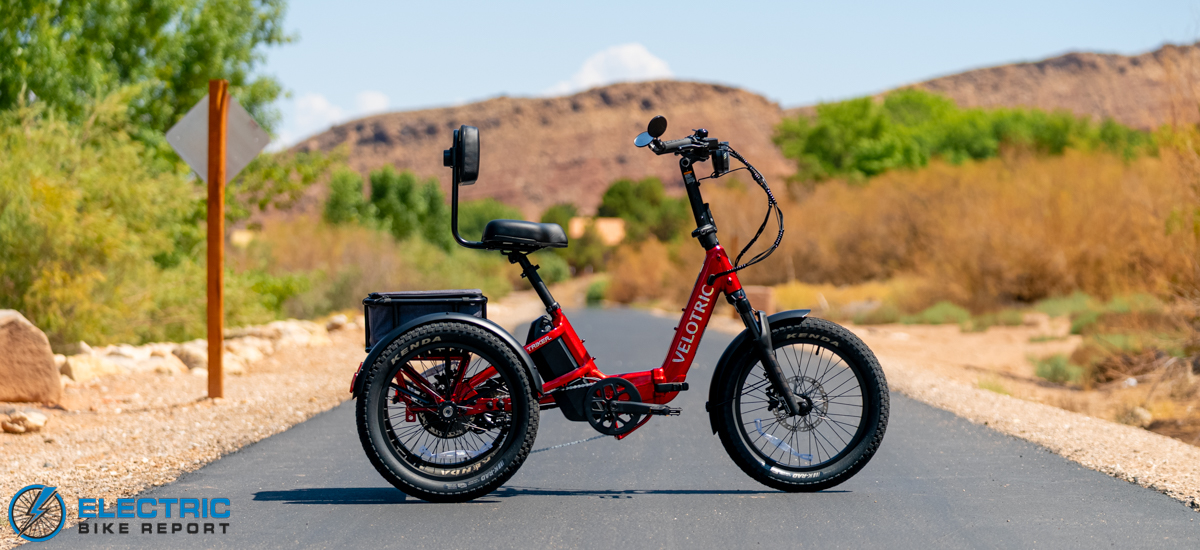
In recent years, we’ve seen a growing number of e-bike brands competing for attention in the entry-level electric tricycle market. These budget-tier models are often functional, accessible, and appealing to new riders, but by their very nature, their specs and performance are limited by their price.
With the Triker, a polished and relatively robust mid-tier e-trike, Velotric opted to appeal to those who want more than just the basics.
The difference is visually obvious, with the three-wheeler’s sleek lines and glossy, automotive-quality paint job. But what’s under the proverbial hood is more important; the Triker’s sturdy frame and 750W motor give it the ability to move up to an advertised 500-lb total payload. A high-capacity 804-Wh battery offers an advertised range of up to 60 miles.
Like other Velotric models, the Triker also boasts an uncommonly high degree of customization!
For example, the brand’s SensorSwap technology offers a choice between the natural, active feel of a torque sensor or the relaxed, low-effort experience of a cadence sensor. The two modes each have their place; riders heading out for exercise may choose the former, while switching to the latter when carrying a load of groceries or tackling a hilly path.
Additionally, the Triker features two ride settings with different speed limits. A user-friendly Beginner Mode limits its top speed to a safe and controlled 8 mph across three pedal assist levels, while the Standard Mode offers adjustable speeds up to 20 mph over five settings for those who are comfortable with the trike’s handling and operation.
We tested the Triker’s features, feel, and performance in our typical array of standardized performance tests. See the full review below for all the details!
Class 2 (throttle to 20 mph)
 Pros
Pros- Comfort takes a front seat with the Triker, thanks to its roomy geometry, cushy saddle, and ergonomic handlebars/grips.
- While many trikes can feel tippy when cornering, the Triker feels stable and planted, thanks to its wide tires and heavy frame.
- Like all Velotric models, users can customize many aspects of the ride, including speed, sensor mode, throttle behavior, and more.
- Velotric designed the Triker to fit riders between 4’10” and 6’5” with plenty of adjustability, including a dual-telescoping seatpost and a 180-degree adjustable stem.
- It offers many appreciated safety features, such as the trike’s 8 mph Beginner Mode, integrated lights and turn signals, and full UL certification.
- The Triker is loaded with uncommon extras! It includes side mirrors, a cargo basket with a liner, a cruise control function, and Apple Find My™ technology for security.
- It pairs with the Velotric app, offering ride and health data tracking, as well as quick access to customization options.
- With an 80mm suspension fork and semi-knobby 20×3” tires, the Triker can comfortably handle smooth dirt or gravel paths.
- Velotric offers bold color options in glossy, automotive-quality paint.
 Cons
Cons- Some frame flex is common with step-thru electric trikes, but we found the Triker’s frame more compliant than we’d prefer. We encourage Velotric to stiffen it on the next model.
- While it may not happen on every trike, our saddle consistently loosened over time while riding. We suggest that Velotric use a more secure saddle mount.
- Battery: 48V, 804 Wh (16.75 Ah), IPX7, Certificated by UL 2271
- Display: 3.5″ Full color, High brightness, Bluetooth, Adjustable angle
- Motor: 48V, 750W,1300W Peak, 90Nm
- Headlight: Light sensing 130 Lux /500 LM high-output integrated LED, adjustable angle
- Taillights:Braking Indicator, turn signal, rear light steady/flash, integrated with rear rack
- Pedal Assist: 5 PAS Levels
- Claimed Range: 60 Miles (Pedal Assist) / 50 Miles (Throttle)
- Throttle:Trigger-control, removable
- App:Velotric App
- UL Certification:UL 2849 & UL 2271 Certified
- Claimed weight: 85.8lbs
- Tested Weight: 98.1 lbs (including 10.8 lb battery)
- Rider height range: 4’10”-6’5”
- Total payload capacity: 500 lbs
- Brakes:Hydraulic Disc Brake, 180mm Front and Rear Rotors
- Fenders:Front and rear full coverage
- Fork:Hydraulic suspension 80mm travel with Lock-out
- Frame: Aluminum Alloy
- Drivetrain: SHIMANO 7-speed, 40T chainring, 11-28T freewheel, KMC chain
- Grips: Durable ergonomic grips, lockable
- Saddle: VELOTRIC Triker seat with adjustable back rest
- Handlebar: Aluminum Alloy, Φ31.8mm, 660mm
- Kickstand: Parking Brake
- Pedals: Plastic
- Tires: KENDA 20×3.0″ eBike puncture-resistant tires
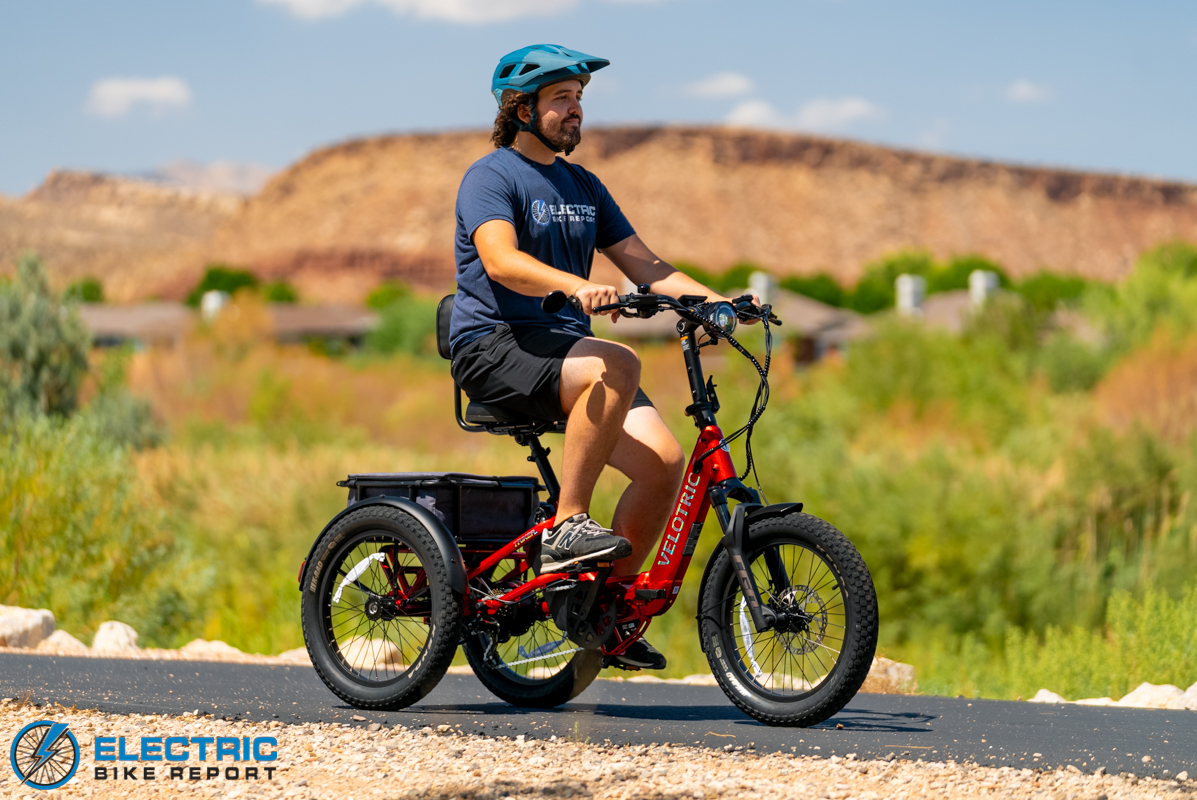
In its Beginner Mode, the Triker offers three pedal assist levels with a top speed of 8 mph.
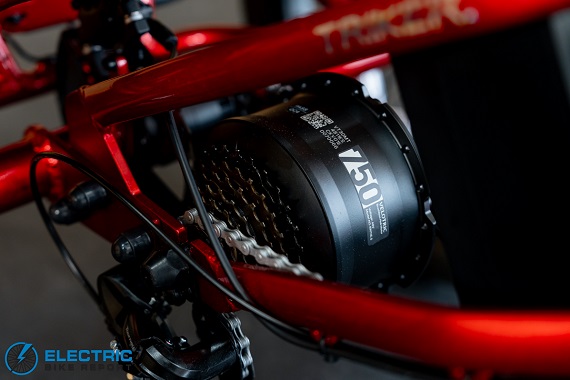
The Triker’s 750W motor makes short work of hills and can deliver power in through either a torque or cadence-sensing mode.
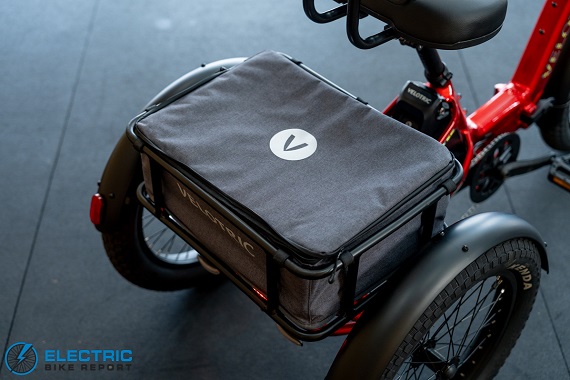
We appreciate the Triker’s thoughtful extras, including a sizable cargo basket with a zippered fabric liner/cover.
Velotric Triker Review: Speed Test
The goals of our Speed Test were to find out if the Triker could reach its advertised maximum speeds, learn how quickly its throttle could accelerate, and gain an understanding of the bike’s feel and programming in each of its pedal assist system (PAS) settings.
We tested it on a paved shared-use trail, riding in both torque and cadence-sensing modes while tracking our average speed. While the Triker ships with a 12 mph maximum speed, users can adjust this limit up to 20 mph, so we also tested it with both the default and highest speed limits. Our data is graphed above.
In the cadence mode test, each of the trike’s PAS levels carried our test rider, Griffin, up to a preset speed limit. As shown in the graph of his results, each assist level delivered a measured increase in speed, with a balanced distribution of power across the trike’s five PAS levels. The Triker also reached its maximum speeds with relative ease.
Griffin’s results in the torque mode test were generally similar, though he was able to reach the 12 mph maximum speed in PAS 4 (a difference in speeds between PAS 4 and PAS 5 would still likely be noticeable if measured on a hill). When set to 20 mph, the trike delivered the largest jump in power between PAS 1 and 2, which leveled off gradually as the PAS level was increased.
As expected, the two modes had a major difference in feel. The motor powered the trike up to speed with minimal pressure on the pedals when in cadence mode. In torque mode, its power output was dependent on more applied effort from the rider.
Regardless of the riding mode, the Triker felt safe and controlled in all settings, with a more gradual and relaxed feel in its lower assist levels, and livelier, more energetic power delivery in the higher modes.
It felt similarly manageable when using the throttle. We liked that the throttle could be set to share the same PAS-setting-based speed limits as when pedaling in the cadence-sensing mode; by default, it shares these limits in cadence mode, but can reach 20 mph regardless of PAS setting when in the torque-sensing mode.
In short, the Triker met our expectations for an electric trike in this test, giving riders a safe and well-balanced range of pedal assist settings and riding modes to choose from.
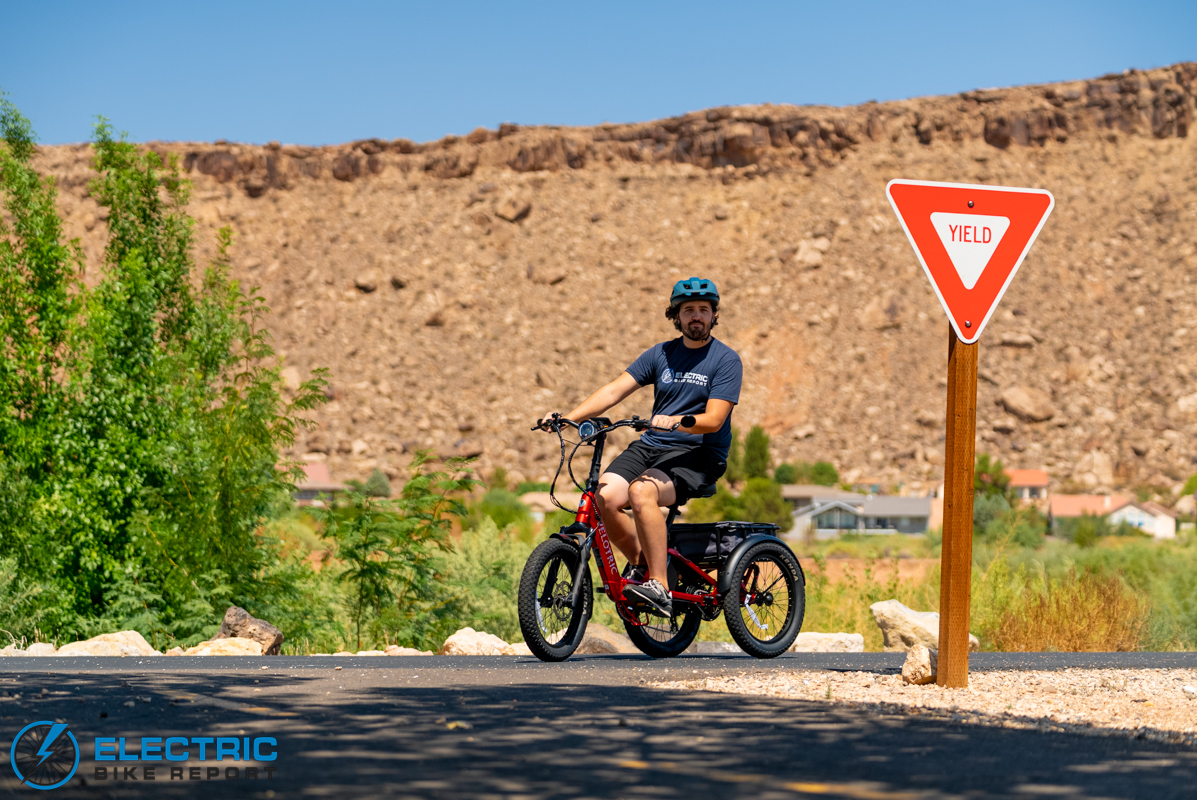
Once unlocked to its Standard Mode, the Triker has five pedal assist levels and a 12 mph maximum speed, though it can be set up to 20 mph.
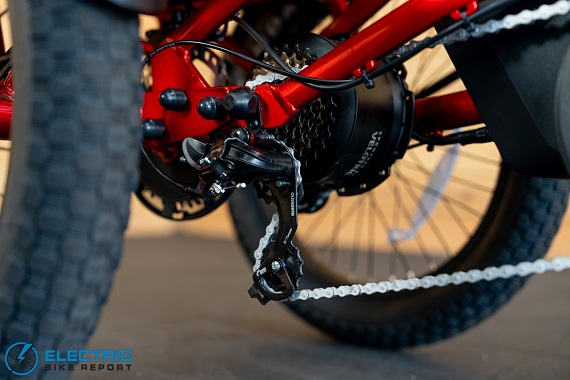
While many e-trikes offer limiting single-speed drivetrains, the Triker has a more flexible 7-speed cassette.
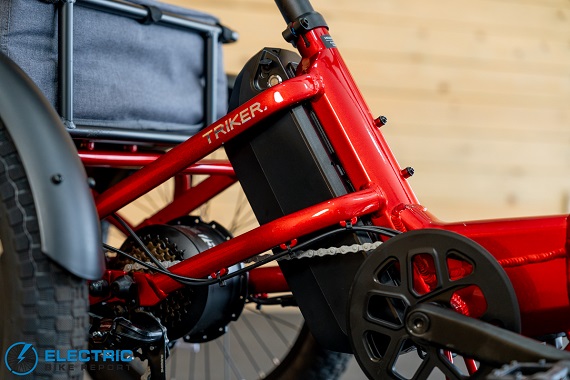
The trike’s 840-Wh battery is substantially larger than what you’ll find on most entry-level models.
Velotric Triker Review: Range Test
Our usual range test method is explained in the graphic above. Considering that Velotric Triker carries a sizable 804 watt-hour (Wh) battery with the potential for tremendous range, and that most riders aren’t likely to travel at 6-7 mph for such distances, we opted to focus solely on its minimum range using its highest power level.
As shown, our test rider managed nearly 41 miles when using the Triker’s torque-sensing mode and a maximum speed of 14 mph (above the default setting, but closer to the maximum speed of most other e-trikes we’ve reviewed).
The Triker’s result is significantly above average when compared to the minimum range of similar models we tested; a group of comparable e-trikes traveled 29.1 miles in their highest assist levels.
Velotric’s model had two major advantages. First, the other trikes had smaller batteries averaging 587 Wh (many also had less powerful motors that didn’t require such high capacity). Additionally, while other models used less-efficient cadence sensors, the Triker’s torque sensor allowed its motor output to fluctuate, thereby reducing the draw on its battery.
Of course, prospective buyers should be aware that riding at higher speeds, carrying cargo, and/or using the Triker’s cadence-sensing mode will likely result in shorter range. Those using a lower assist level and/or slower speeds may exceed our results.
Velotric advertises that riders using only the throttle at 12 mph should achieve up to 50 miles, while those using the lowest PAS setting may reach up to 60, and we consider those estimates doable.
Either way, the Triker’s results are impressive, especially considering that most trike riders we’ve interacted with take relatively short rides in the neighborhood of 10 miles. The ability to take multiple trips before needing to recharge is user friendly and should alleviate any range anxiety.
One minor point of critique we identified during this test was the display’s bar-based charge indicator; we find percentage-based readouts more reliable and easier to judge. Fortunately, the Velotric app shows the battery percentage, so we recommend that those in our camp get a phone mount for the handlebars and make use of the app while riding.
A final detail for this section: the Triker ships with a 3-amp fast charger that can have the 16.75 amp-hour battery recharged in roughly 5.5 hours.
Velotric Triker Review: Hill Test
The Velotric Triker did a fantastic job in our Hill Test. We used the process and location explained above to measure its climbing ability; its throttle and pedal times when using the cadence-sensing mode were identical.
At this point in time, comparison with similar models is difficult for two reasons. First, we recently moved our Hill Test to the Devil’s Backbone from our previous location, called Hell Hole Trail, so we are still in the process of building a new dataset.
Second, the Triker is the first e-trike we’ve tested with a 750W motor (others had 500W motors) so it naturally has a faster and easier climbing experience. The proof is in the pudding: when compared directly with another 500W model, the Triker reached the top of the hill 18 seconds faster on throttle power and 14 seconds faster when pedaling.
The Triker’s motor produces a mighty 1300W and up to 90 Newton meters (Nm) of torque—more than enough power to move it, a rider, and a heavy load of cargo up an intimidating hill. With so much muscle behind its ride, we consider the Triker to have thoroughly conquered the Devil’s Backbone.
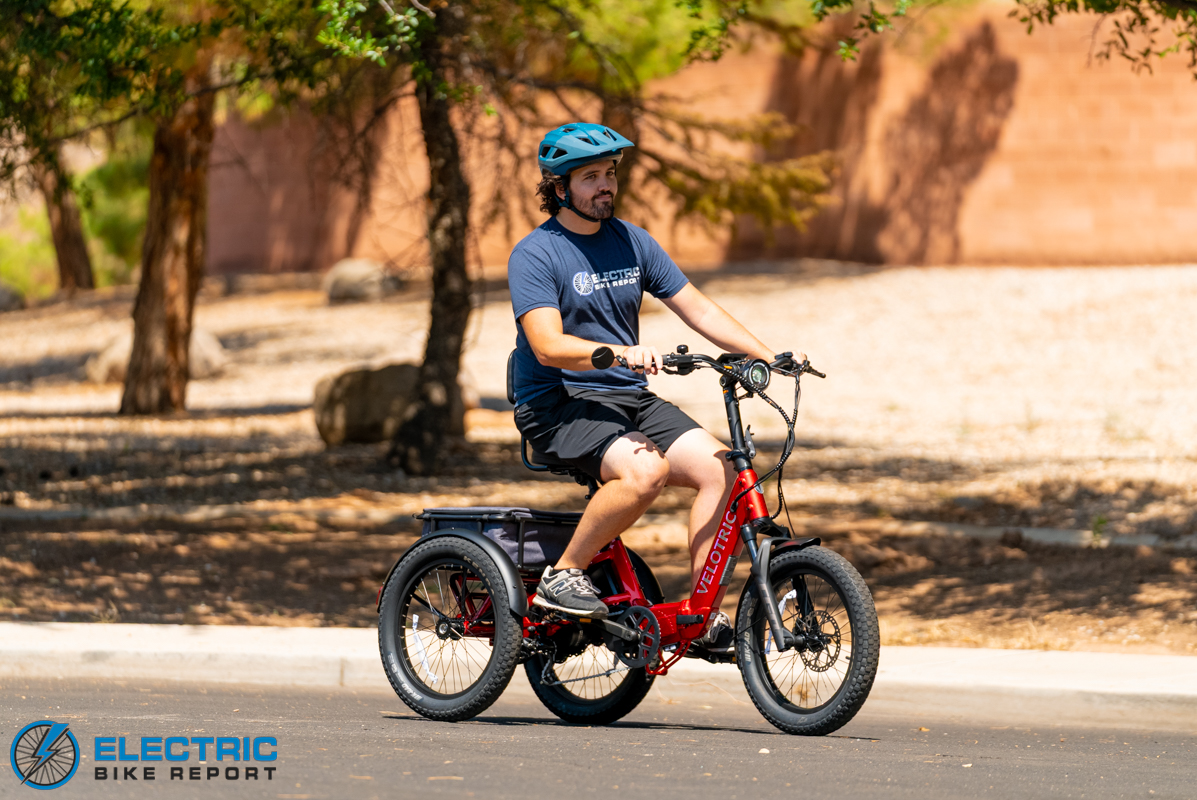
The Triker has three color options. Ours is “Cherry Crimson,” but Veloric also offers it in “Electric Blue” and “Pearl White.”
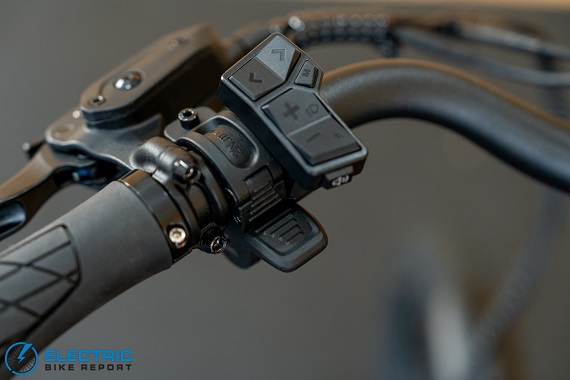
A left hand thumb throttle allows riders to relax and let the motor do the heavy lifting.
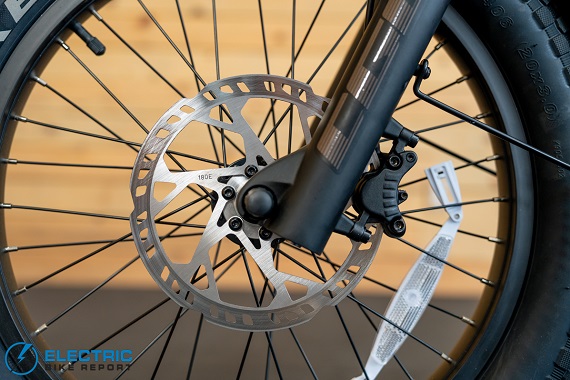
The 180mm rotors are thicker than average, at 2.4mm.
Velotric Triker Review: Brake Test

Continuing its trend of great performance, the Triker’s hydraulic brake system proved quite effective in our Brake Test. Using the process above, we found its average stopping distance to be 11’ 1”, a full two feet shorter than the average among similar models we’ve tested (13′ 1”).
At face value, the Triker’s brakes are relatively standard among similar models with hydraulic brake setups. It uses unbranded brake levers and calipers paired with a 180mm rotor on the front wheel and a second centered on the rear axle.
Looking closer, however, the rotors are thicker than average (2.4mm instead of the more common 1.8mm). This extra thickness aids in heat dispersion when the brakes are applied, which prevents fade and results in faster deceleration.
Considering the Triker’s price of between $2,000 and $2,500, we hoped to see it outfitted with a name-brand brake system, but as our testing showed, the currently-specced brakes are highly effective. Ultimately, potential buyers can rest assured that the Triker is safe and well-equipped for its speeds and weight capacity.
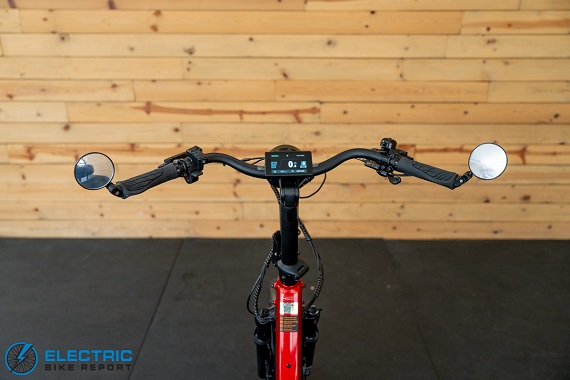
The wide, ergonomically-curved handlebars are comfortable and easy to hold on to.
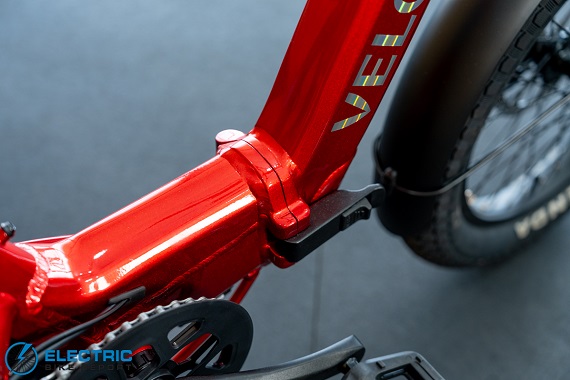
A central hinge in the frame allows the Triker to fold when it’s not being ridden
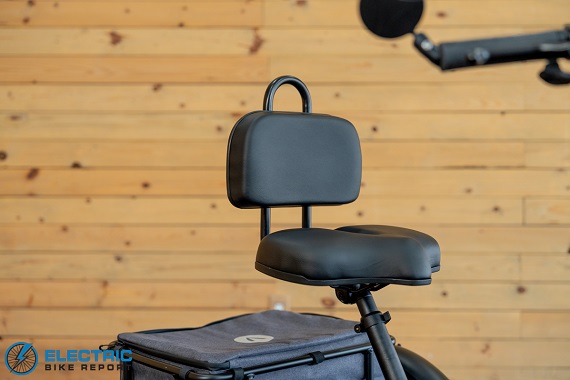
The saddle and its adjustable backrest felt cushy and comfortable.
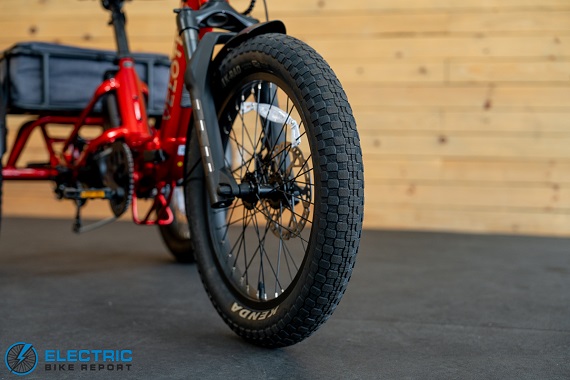
Kenda’s K-Rad tires offer stability, cushion, and traction on paved and unpaved surfaces.
Velotric Triker Review: Ride Quality
Ride quality is a measure of how a bike or trike feels to ride, and involves a complex combination of factors, such as geometry, handling, motor engagement, the user interface, and more.
As has been common in our previous experiences with Velotric products, the Triker’s ride quality was excellent overall; it focuses on comfort, user friendliness, and practicality. This section does, however, contain our largest points of critique regarding the frame and saddle mount.
Velotric advertises that the Triker is designed to fit riders from 4’10” to 6’5”. We found it to be uncommonly accommodating, with a dual-telescoping seatpost and a roomy cockpit, allowing us to reach full leg extension for comfort and efficiency when pedaling. A 180-degree adjustable stem allowed for an unexpected degree of adjustability in handlebar height and reach.
The trike’s thick, supportive saddle and its adjustable backrest was a highlight, along with the ergonomically-curved handlebars and rubber grips. Due to its friction-clamp system, however, we found that the saddle loosened while riding regardless of how much we tightened it; we encourage Velotric to use a more secure mounting bracket to avoid this.
Comfort was enhanced by the Triker’s 80mm suspension fork (which includes lockout and preload adjustment features) and tires. The combination of a front suspension and the checkerboard-patterned 20×3” Kenda K-Rad tires provides the shock absorption and grip needed for paved roads and paths. It also lends the Triker some off-road potential, too, giving riders the ability to explore dirt or gravel multi-use trails and the like.
Delta-style tricycles (two rear wheels and a single wheel in the front) like the Triker often require some caution when taking corners to avoid tipping up on two wheels. Riders used to the handling of a bicycle will want to slow down and lean into the turn with their upper body; for this reason, we often say that slower is safer when riding an e-trike.
Due to its above-average weight of nearly 100 lbs (98.1 including the battery, by our scales), we found the Triker more stable and planted than most, as the heft of its frame kept it stuck to the ground. For this reason, it handled its higher-than-average maximum speed of 20 mph well, though we still advocate for caution when riding—and especially when cornering.
Frame flex is a relatively common factor on e-bikes and trikes with step-thru (ST) frames. Our test riders, who weigh 230 lbs at maximum, found the Triker’s frame flex acceptable for their size. Considering the total 500-lb payload capacity, however, it was more present than we hoped, so we encourage Velotric to stiffen the frame in future iterations.
Like many of the best electric trikes we’ve tested, the Triker has a folding frame and a collapsible stem, allowing it to take up less space when stored, shipped, or transported in a larger vehicle. Considering its weight, we don’t expect many users will take advantage of this feature, but those who do can shave off roughly 10 lbs by removing the battery.
We appreciated the Triker’s well-equipped nature; with fenders, a bright headlight, integrated brake lights and turn signals, and fabric-lined cargo rack, it’s ready for practical use right out of the box. Its multi-speed drivetrain is also worth mentioning; compared to the ghost-pedaley single-speed drivetrains often used by e-trikes, this allows riders to stay engaged and active while pedaling.
The customization features I mentioned in the introduction to this review are other standouts. In addition to changing the riding mode and selecting between torque/cadence-sensing modes, users can adjust throttle and PAS speeds separately, choose from three brake light patterns, and opt to have the throttle’s speed limited by the selected PAS setting.
These features are accessible through the Triker’s display menu or the Velotric app. The app also offers ride data tracking and syncs with the Apple Health app. Speaking of Apple, the Triker also includes the company’s Find My™ technology, which can help users locate their e-trike in the event of theft.
Overall, the Triker offers users a comfortable ride with an adaptable fit, a robust but not overcomplicated user interface, a largely customizable ride feel, and a relatively uncommon degree of versatility in where and how it can be used.
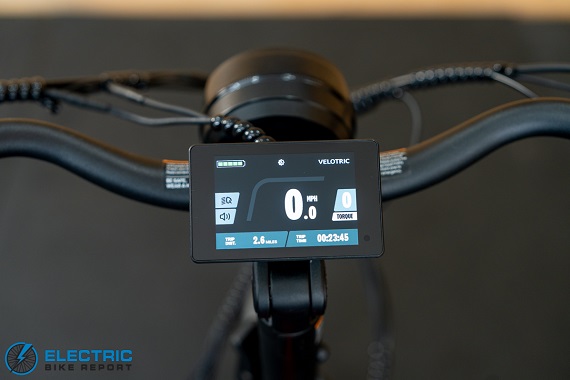
Velotric’s color display is well-organized, clean-looking, and easy to read.
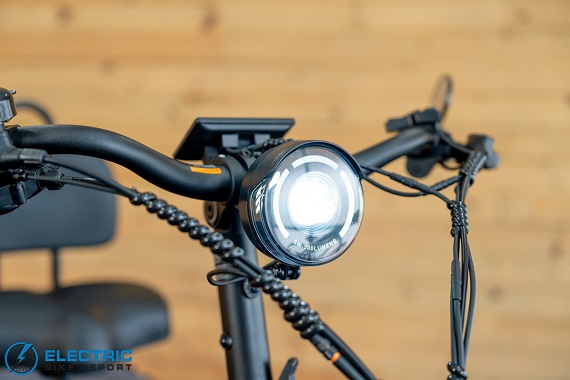
The bright headlight includes an automatic feature to turn on in low light conditions.
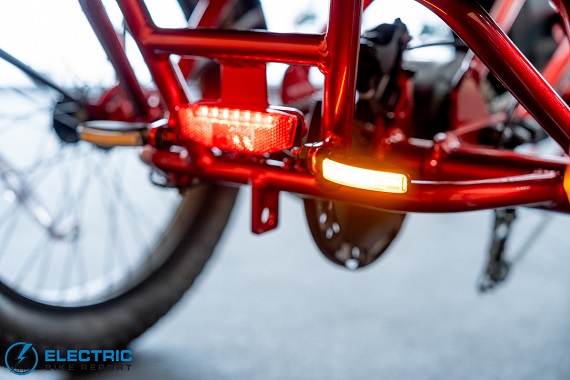
The Triker includes turn signals on either side of a taillight mounted beneath the cargo rack.
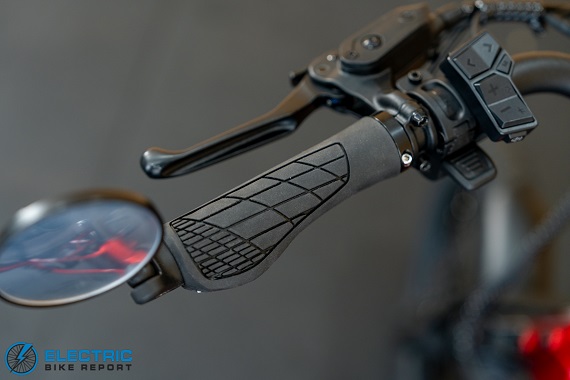
Ergonomic rubber grips include side mirrors for extra safety and visibility!
Velotric Triker Review: Summary / Where to Buy
Considering how flooded the entry-level electric trike market currently is, I think Velotric was smart to set their sights slightly higher with the Triker. The brand’s first e-tricycle offers a roomier feel, a more powerful motor, a sharper look, and a more customizable experience than we’ve seen on similar models.
These elements justify its higher price—and we feel that the Triker delivers excellent value overall with its features and performance. While we compared it against models that, on average, cost significantly less, it excelled in all areas of our testing.
In our Speed Test, it delivered power responsively in a balanced and safe manner, carrying it to its advertised top speed in each of its riding modes. In our Range Test, its larger-than-average battery proved able to keep it on the go for an impressive distance. In our Hill Test, it conquered a taxing climb with relative ease. And finally, in our Brake Test, it demonstrated safe and reliable stopping power.
The largest areas with room for improvement were its saddle mount and frame. The former would benefit from a more secure tightening method. The latter would likely work better for heavier riders or those carrying a high payload after some stiffening. Otherwise, the Triker continues Velotric’s tradition of delivering mobility devices defined by their comfort, adaptability, effectiveness, and style.
Based on our experience, we recommend the Triker for those seeking the accessibility and stability of a tricycle. More specifically, it’s well suited for those who are willing to pay a little more to get a more premium experience when compared to most entry-level models.
Whether used for grocery runs, exercise, or simple enjoyment, the Velotric Triker allows riders to go farther and potentially faster with the feel they prefer.
Happy Riding! Make sure to let us know if you have any questions or if you think we left anything out in this review of the Velotric Triker down in our comments section.



